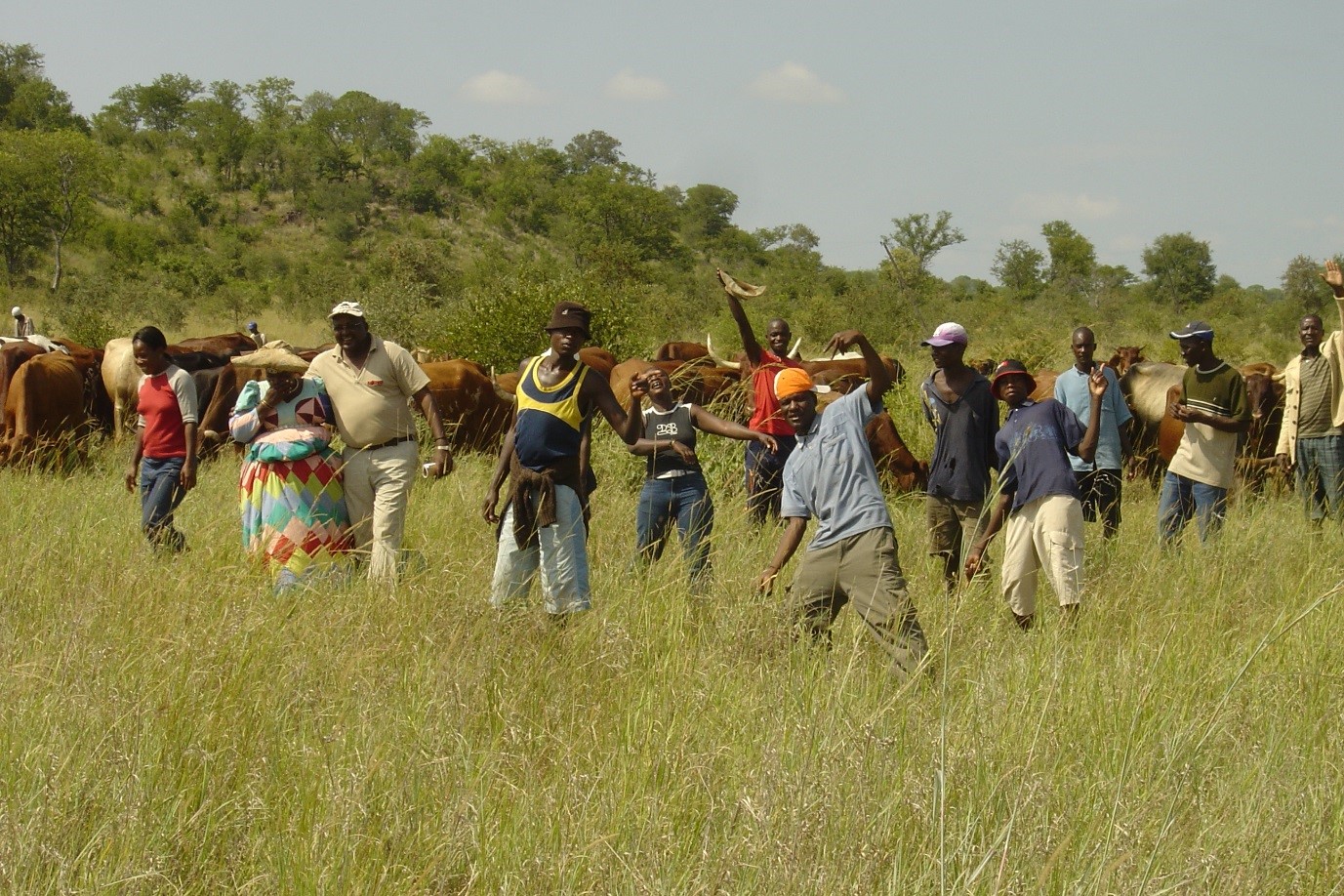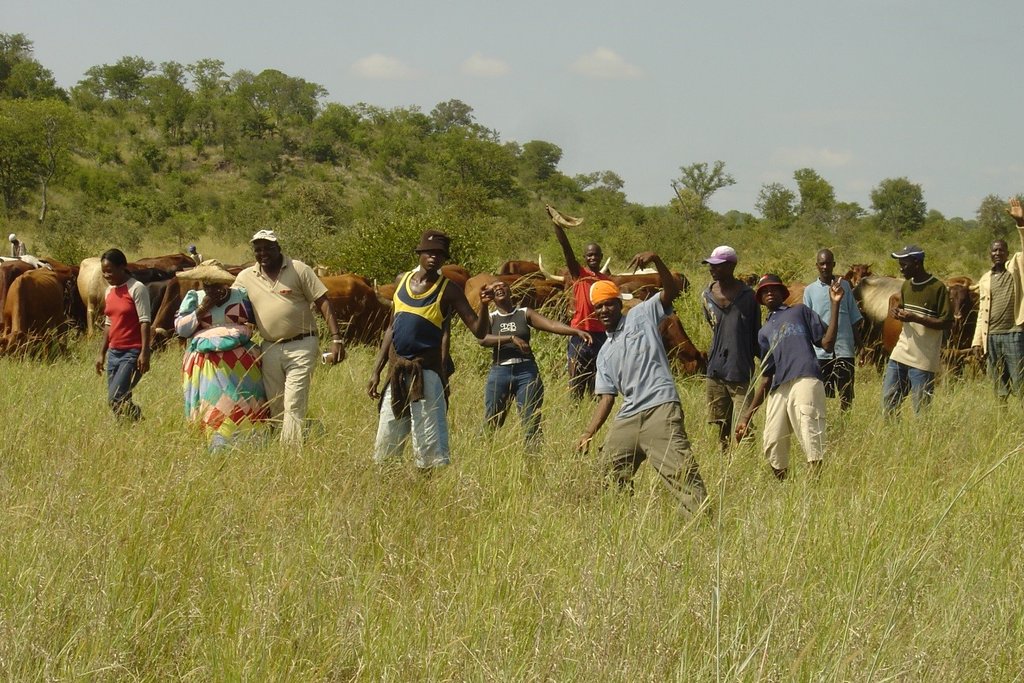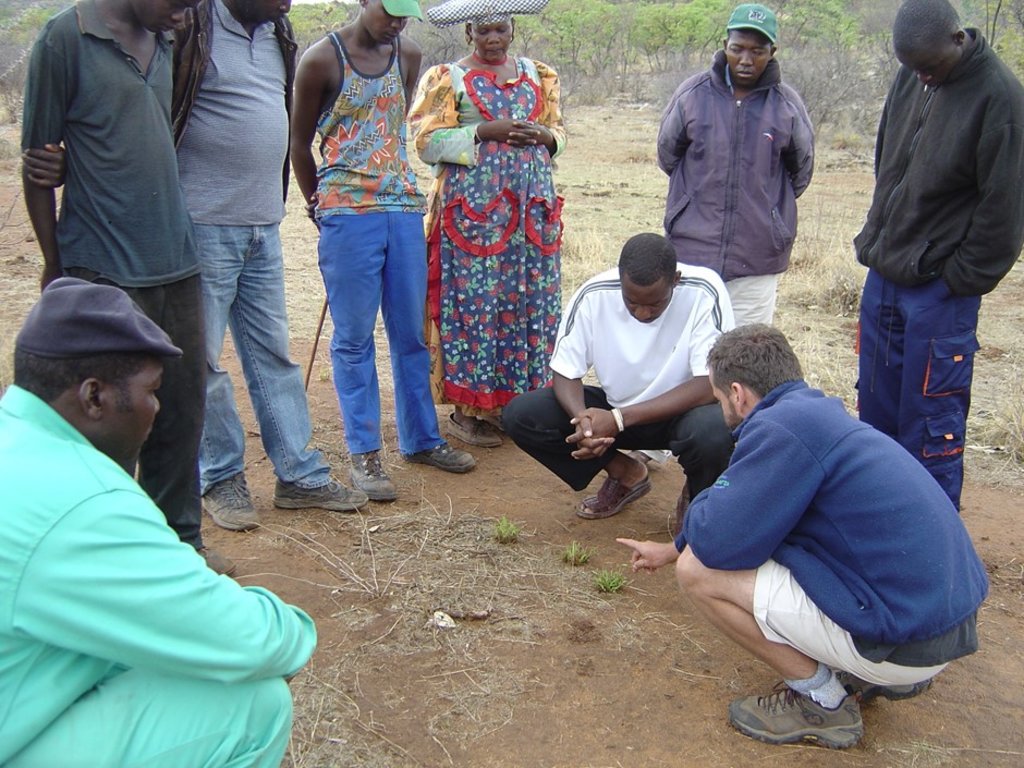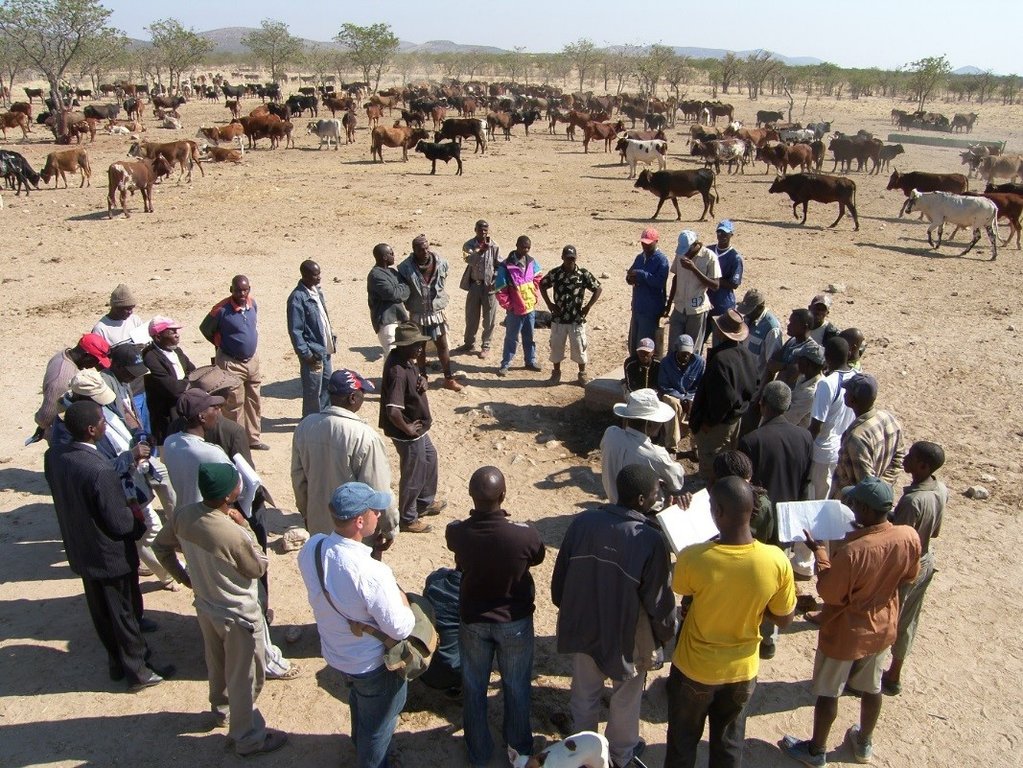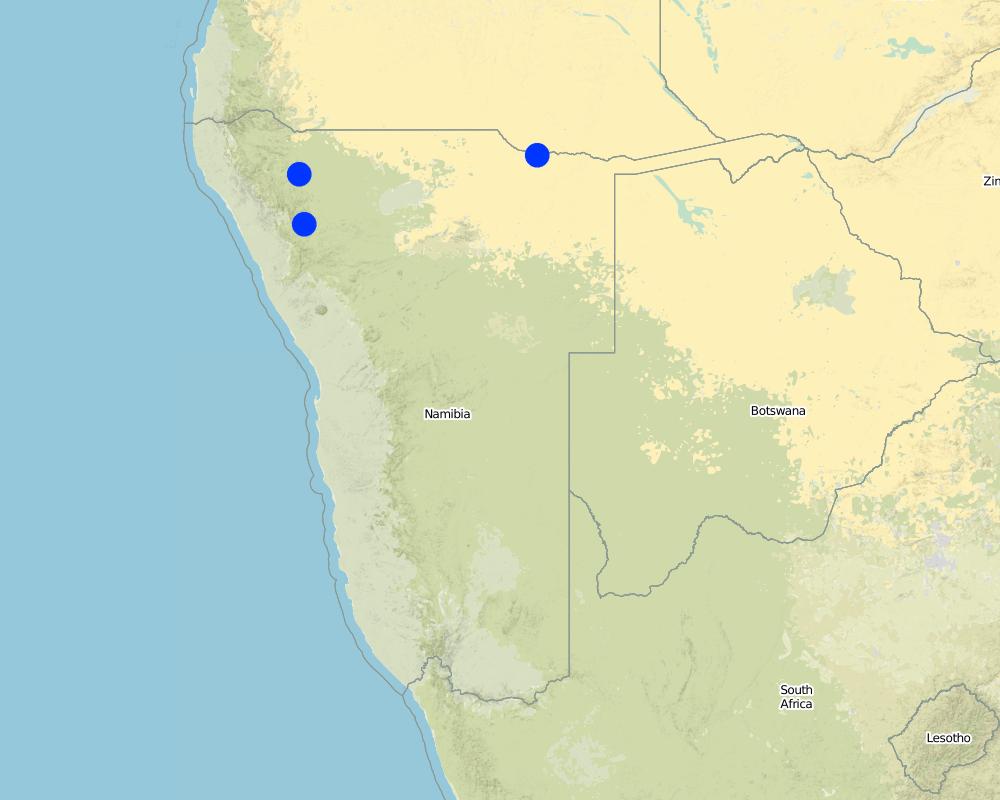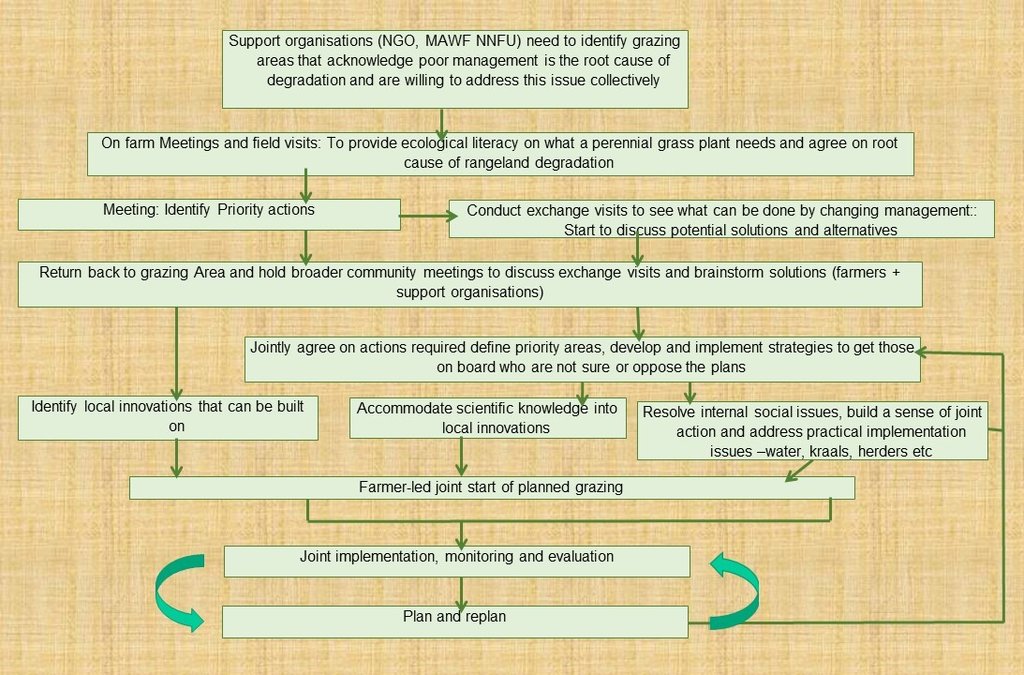Communal grazing management [นามิเบีย]
- ผู้สร้างสรรค์:
- การอัพเดท:
- ผู้รวบรวม: Ibo Zimmermann
- ผู้เรียบเรียง: –
- ผู้ตรวจสอบ: Rima Mekdaschi Studer
Omarisiro wovinamuinjo motjimbumba
approaches_3050 - นามิเบีย
ดูส่วนย่อย
ขยายทั้งหมด ย่อทั้งหมด1. ข้อมูลทั่วไป
1.2 รายละเอียดที่ติดต่อได้ของผู้รวบรวมและองค์กรที่เกี่ยวข้องในการประเมินและการจัดเตรียมทำเอกสารของแนวทาง
ผู้ใช้ที่ดิน:
ชื่อของโครงการซึ่งอำนวยความสะดวกในการทำเอกสารหรือการประเมินแนวทาง (ถ้าเกี่ยวข้อง)
Southern African Science Service Centre for climate change and Adaptive Land management (SASSCAL)ชื่อของโครงการซึ่งอำนวยความสะดวกในการทำเอกสารหรือการประเมินแนวทาง (ถ้าเกี่ยวข้อง)
Conservation Agriculture Namibia (Conservation Agriculture Namibia) - นามิเบียชื่อของโครงการซึ่งอำนวยความสะดวกในการทำเอกสารหรือการประเมินแนวทาง (ถ้าเกี่ยวข้อง)
Zakumuka Producers Co-operative (Zakumuka Producers Co-operative) - นามิเบีย1.3 เงื่อนไขที่เกี่ยวข้องกับการใช้ข้อมูลที่ได้บันทึกไว้ผ่านทาง WOCAT
วันที่เก็บรวบรวมข้อมูล (ภาคสนาม):
2017
ผู้รวบรวมและวิทยากรหลักยอมรับเงื่อนไขเกี่ยวกับการใช้ข้อมูลที่ถูกบันทึกผ่านทาง WOCAT:
ใช่
1.4 การอ้างอิงถึงแบบสอบถามเรื่องเทคโนโลยี SLM
2. คำอธิบายของแนวทาง SLM
2.1 การอธิบายแบบสั้น ๆ ของแนวทาง
Facilitation of agreement among community members to jointly manage their communal grazing area by combining their livestock into a single herd to be driven to different portions of the grazing area. This is done in accordance with an agreed growing season plan that provides sufficient recovery for grazed grasses to reinvigorate themselves and a non-growing season plan to graze perennial grasses and prepare soil and plants for the upcoming growing season for regenerating rangeland productivity and well-being.
2.2 การอธิบายอย่างละเอียดของแนวทาง
การอธิบายอย่างละเอียดของแนวทาง:
The approach is a partnership between NGO, Ministries of Lands and Agriculture, National Farmers Union, traditional authorities and regional and local government. The NGO facilitates community members to recognise the damage caused to the rangeland by their individual herds of livestock grazing continuously on the same grass plants, and to appreciate the benefits that planned grazing can bring about. Farmers host facilitators on their land where the current state of the land is compared to that of the past and the reasons for the decline are investigated. Once farmers understand that all perennial grass plants need recovery and that continuous grazing depletes the root reserve, the land users soon conclude that it was their management that resulted in the loss of perennial grass and increase in bare ground. Once the root cause of the problem is established, the aim of the approach can be pursued, which is to regenerate rangeland productivity in the communal grazing area and thereby support higher production of livestock to in turn support livelihoods of the community. The focus on rangeland results from identifying and addressing the weakest link in the chain of production (converting sunlight to grass, or grass to meat, or meat to money) in a viable and upscalable manner. If motivation to apply planned grazing exists and there is sufficient cohesion among the community members, then their right to claim common property ownership of their grazing area needs to be established. In these pioneering communities this required at least 10 village level livestock owner meetings each to decide on the modalities of how to start planned grazing. These meetings continue after planned grazing has started to deal with ongoing planning as well as other aspects including animal production and marketing. Exposure visits to areas with successful grazing management helps to motivate community members. On returning home frequent follow-up meetings were facilitated by the same NGO and the Ministry of Agriculture to resolve local issues, which included overcoming traditional taboos, such as combining animals in one overnight kraal as well as whose bulls would be kept in the herd and how this would be managed. Boundaries with grazing areas of neighbouring communities need to be clearly mapped, recognised and respected by all. In case of grass poaching, the offender/s need to be swiftly and firmly dealt with, preferably through customary law. A grazing plan needs to be agreed upon by all livestock owners in the given grazing area, and endorsed by the local Traditional Authority. The Grazing Area (GA) is then mapped, while herders are appointed though agreement among all livestock owners. At night the cattle are kraaled nearby individual homesteads of their owners, where milking may take place and animals are attended to if necessary. In the morning, the appointed herders collect cattle from the different kraals (or joint kraal) and herd them to the designated portion of the grazing area for that day. Different portions of the grazing area are grazed from day to day and should not be returned to until the grazed grass has replenished its root reserves sufficiently, usually some months later. This was started at Erora in 2004, facilitated by the NGO, Integrated Rural Development and Nature Conservation (IRDNC). Implementation started in 2006, combining approximately 1200 cattle from 12 households. Farmers noticed a higher density of annual grasses after the first season, dramatic improvement in soil cover after 3 years with emergence of grass seedlings where none had grown on the hard-capped soil for decades. Then after three years, the farmers noticed the return of perennial grasses and increased biodiversity in many parts of the grazing area. However, when the extended drought started in 2011, planned grazing was interrupted and erosion gullies expanded into the grazing area, down which rainwater flowed off the landscape, thus dehydrating the rangelands. The drought lasted for five years, during which the planned grazing was temporarily discontinued in 2013. Instead, restoration work was initiated in 2014 by constructing bush filters at critical control points along key gullies, when facilitation was taken over by another NGO, Conservation Agriculture Namibia (CAN). After the region experienced successive years of severe drought and cattle in 2014 became too weak to be rounded up from all the kraals, the community members decided to revert to keeping cattle continuously near their homesteads. This had been intended as a temporary measure until surviving cattle gained sufficient strength to be rounded up from kraals and herded again, which only occurred in 2017. The communal grazing management approach was extended to other villages such as Outokototua and Nsindi in 2012, despite the drought. New boreholes were drilled and installed in all three areas to facilitate improved planned grazing.
2.3 รูปภาพของแนวทาง
2.4 วีดีโอของแนวทาง
ความคิดเห็น อธิบายสั้นๆ:
www.youtube.com/watch?v=xNyFkDUH6MQ
This video is from a DVD created by the Integrated Rural Development and Nature Conservation (IRDNC), a Namibian NGO and co-sponsored by the Namibian Ministry of Agriculture and the Namibian National Farmers Union. The video documents the development of a rangeland program focused on Holistic Management, spearheaded by Colin Nott, a Holistic Management educator.
วันที่:
2007
สถานที่:
Erora, Namibia
ชื่อของผู้ถ่ายวีดีโอ:
Andrew Botelle
ความคิดเห็น อธิบายสั้นๆ:
www.youtube.com/watch?v=3Ey5v40KtkI
Combined herding to manage communal grazing with the use of stress-free handling of cattle,
วันที่:
2007
สถานที่:
Erora, Namibia
ชื่อของผู้ถ่ายวีดีโอ:
Andrew Botelle
ความคิดเห็น อธิบายสั้นๆ:
www.youtube.com/watch?v=6C4V_Cib8ts
Managing water flow to repair gully erosion
วันที่:
2015
สถานที่:
Namibia
ชื่อของผู้ถ่ายวีดีโอ:
Andrew Botelle
2.5 ประเทศ ภูมิภาค หรือสถานที่ตั้งที่ได้นำแนวทางไปใช้
ประเทศ:
นามิเบีย
ภูมิภาค/รัฐ/จังหวัด: :
Kunene Region
ข้อมูลเฉพาะเพิ่มเติมของสถานที่ตั้ง:
Erora village, 18.32637 South, 14.05912 East
Map
×2.6 วันที่เริ่มต้นและสิ้นสุดของแนวทาง
ระบุปีที่เริ่ม:
2004
ความคิดเห็น:
Combined herding was discontinued at Erora in 2013 due to extreme drought, which ended in 2016/2017 rainy season, and land users are planning to use reserved grazing, whereby cattle are taken out each day by herders and left there to return on their own to water points. In the meantime, combined herding has already resumed at the Outokotorua grazing area.
2.7 ประเภทของแนวทาง
- Science informs the traditional practice
2.8 เป้าหมายหรือวัตถุประสงค์หลักของแนวทาง
To regenerate rangeland productivity for supporting livelihoods and improved quality of life.
2.9 เงื่อนไขที่เอื้ออำนวยหรือเป็นอุปสรรคต่อการนำเทคโนโลยีภายใต้แนวทางนี้ไปปฏิบัติใช้
บรรทัดฐานและค่านิยมทางสังคม วัฒนธรรม ศาสนา
- เอื้ออำนวย
Herding is customary, and the task is now shared among families
- เป็นอุปสรรค
Herding no longer carries the high social status that it deserves
การมีไว้ให้หรือการเข้าถึงแหล่งการเงินและบริการ
- เอื้ออำนวย
No bought inputs are required, and fewer herders needed than with many small herds. Also fewer losses from stock theft and predators
การจัดตั้งระดับองค์กร
- เอื้ออำนวย
A grazing area committee was established with support of livestock owners
- เป็นอุปสรรค
The grazing area committee is not legally recognised
การร่วมมือหรือการทำงานประสานกันของผู้ลงมือปฏิบัติ
- เอื้ออำนวย
Partnership approach with Ministries of Lands and Agriculture, the Namibia National Farmers Union, traditional authorities and regional and local government
- เป็นอุปสรรค
Resolution of local issues to apply grazing plans needs to be resolved
กรอบแนวทางในการดำเนินการด้านกฎหมาย (การถือครองที่ดิน สิทธิในการใช้ที่ดินและน้ำ)
- เอื้ออำนวย
National Policy and strategy is in place which supports sound management principles
- เป็นอุปสรรค
Grass poaching by neighbouring communities is not adequately dealt with by the law
นโยบาย
- เอื้ออำนวย
The approach is based upon the Namibia National Rangeland Management Policy and Strategy
- เป็นอุปสรรค
Common property rights are insufficiently promoted
การกำกับดูแลที่ดิน (การตัดสินใจ การนำเอาไปปฏิบัติใช้ และการบังคับใช้)
- เป็นอุปสรรค
Lack of integration of different scales of management between conservancies at large scales and grazing areas at smaller scale is required
ความรู้เกี่ยวกับ SLM การเข้าถึงการสนับสนุนด้านเทคนิค
- เอื้ออำนวย
The awareness exists among participating livestock owners and stakeholders
ตลาด (จัดซื้อปัจจัยนำเข้า ขายผลิตภัณฑ์) และราคา
- เอื้ออำนวย
The Namibia National Farmers Union is busy addressing markets north of the veterinary cordon fence, which maintains a zone free of foot-and-mouth disease to the south from where farmers are able to access the lucrative EU market
- เป็นอุปสรรค
During drought the drop in prices from sudden increase in supply, results in inability of farmers to sell livestock when sudden shortage of forage occurs
ปริมาณงานที่ทำได้ กำลังคนที่มีให้
- เอื้ออำนวย
Fewer herders are required for one large herd than for many small herds
- เป็นอุปสรรค
The role of herders as managers lacks status and not adequately appreciated, resulting in high turnover of trained grazing area managers and herders
อื่นๆ
- เป็นอุปสรรค
One large livestock owner at a given place can hinder efforts of the majority to improve rangeland management
3. การมีส่วนร่วมและบทบาทของผู้มีส่วนได้ส่วนเสียที่เกี่ยวข้อง
3.1 ผู้มีส่วนได้ส่วนเสียที่เกี่ยวข้องในแนวทางนี้และบทบาท
- ผู้ใช้ที่ดินระดับท้องถิ่นหรือชุมชนระดับท้องถิ่น
Communities of Erora, Outokotorua and Nsindi
To organise, plan and implement
- องค์กรที่ขึ้นอยู่กับชุมชน
Grazing Committee
Oversee day to day implementation
- ผู้เชี่ยวชาญ SLM หรือที่ปรึกษาการเกษตร
Integrated Rural Development and Nature Conservation (IRDNC), then Conservation Agriculture Namibia (CAN) and Namibia National Farmers Union (NNFU)
To facilitate adoption and upscaling of the approach
- นักวิจัย
United States Department of Agriculture (USDA)
To assess rangeland condition changes
- องค์กรพัฒนาเอกชน
First IRDNC, then CAN
To facilitate the approach
- ภาคเอกชน
Zakumuka Producers Cooperative
To organise auctions for sale of livestock
- รัฐบาลระดับท้องถิ่น
Traditional authorities
To support and enable agreed rules
- รัฐบาลแห่งชาติ (ผู้วางแผน ผู้ทำการตัดสินใจ)
Namibian Ministries of Lands & Agriculture
Assist with facilitation and support
- Farmers union
Namibia National Farmers Union
Enabling policy and legislation
ถ้ามีผู้มีส่วนได้ส่วนเสียหลายคนที่เกี่ยวข้องให้ระบุหน่วยงานตัวแทน:
Integrated Rural Development and Nature Conservation (IRDNC), taken over in 2014 by Conservation Agriculture Namibia (CAN)
3.2 การเกี่ยวข้องของผู้ใช้ที่ดินระดับท้องถิ่นหรือชุมชนระดับท้องถิ่นในช่วงต่างๆของแนวทาง
| ความเกี่ยวข้องของผู้ใช้ที่ดินระดับท้องถิ่นหรือชุมชนระดับท้องถิ่น | ระบุผู้ที่มีส่วนเกี่ยวข้องและอธิบายกิจกรรม | |
|---|---|---|
| การริเริ่มหรือการจูงใจ | ปฏิสัมพันธ์ | The community, with focus on livestock owners, youth, women and herders, under facilitation by NGO by conducting exchange visits to neighbouring countries |
| การวางแผน | ปฏิสัมพันธ์ | Feedback was given to communities by participants of exchange visits, grazing committees appointed to contextualise and re-plan for the way forward under guidance of NGO, Ministry of Agriculture, Water and Forestry (MAWF) and Namibia National Farmers Union (NNFU) |
| การดำเนินการ | ปฏิสัมพันธ์ | The grazing committee, livestock owners and herders carry out the grazing plan with support of NGO, MAWF and NNFU |
| การติดตามตรวจสอบหรือการประเมินผล | ปฏิสัมพันธ์ | The grazing committee and livestock owners constantly plan and replan and evaluate results on livestock performance and rangeland and daily check where livestock have grazed and where they will graze next and feed results into re-planning. Annual assessments of forage in May, to determine stocking rate. |
| external assessment of data | จ่ายเงินหรือสนับสนุนจากภายนอก | External assessment by researchers of data gathered by USDA through Innovations for Poverty Action (IPA) |
3.3 แผนผังแสดงขั้นตอนการทำงาน (ถ้ามี)
คำอธิบาย:
Adoption of planned grazing is based on experiential learning of farmers, identification of the root cause of degradation of their rangelands, developing a vision for their future, taking decisions towards this future and solving issues jointly.
ผู้เขียน:
Colin Nott
3.4 การตัดสินใจเลือกใช้เทคโนโลยี SLM
ระบุผู้ที่ทำการตัดสินใจเลือกเทคโนโลยีมากกว่าหนึ่งวิธีไปปฏิบัติใช้:
- ผู้ใช้ที่ดินเป็นผู้ตัดสินใจหลัก โดยการสนับสนุนจากผู้เชี่ยวชาญ SLM
การอธิบาย:
After exposure to sound management techniques and on farm identification and agreement on the root cause of the degradation – the farmers themselves decide if they will continue or not.
ระบุว่าการตัดสินใจตั้งอยู่บนพื้นฐานของ:
- การประเมินความรู้ SLM ที่ได้ทำการบันทึกไว้เป็นอย่างดี (การใช้ข้อมูลในการตัดสินใจ)
- ประสบการณ์และความคิดเห็นส่วนตัว (ไม่ได้ลงบันทึกไว้)
4. การสนับสนุนด้านเทคนิค การสร้างขีดความสามารถ และการจัดการด้านความรู้
4.1 การสร้างขีดความสามารถ / การอบรม
ได้มีการจัดอบรมให้แก่ผู้ใช้ที่ดินหรือผู้มีส่วนได้ส่วนเสียคนอื่น ๆ หรือไม่:
ใช่
ให้ระบุว่าใครเป็นผู้ได้รับการอบรม:
- ผู้ใช้ที่ดิน
- เจ้าหน้าที่ภาคสนาม / ที่ปรึกษา
- Ministry of Agriculture, Namibia National Farmers Union.
ถ้าเกี่ยวข้อง ให้ระบุ เพศ อายุ สถานภาพ ชาติพันธุ์ เป็นต้น:
Inclusion of youth, women and herders
รูปแบบการอบรม:
- กำลังดำเนินการ
- เกษตรกรกับเกษตรกร
- จัดการประชุมสู่สาธารณชน
หัวข้อที่พูด:
On farm(s) exploration of root cause of degradation based on how it was in the past and how it looks now and why this change has happened.
ความคิดเห็น:
A number of issues including: Rangeland management, focussing on the needs of grass plants and soil. Needs of herders, people and stakeholders and how these various needs can be met. Institutional support for grazing committee, focussing on budgeting and financial management.
4.2 การบริการให้คำแนะนำ
ผู้ใช้ที่ดินมีการเข้าถึงการรับบริการให้คำปรึกษาหรือไม่:
ใช่
ระบุว่ามีบริการให้คำปรึกษาหรือไม่:
- ไปเยี่ยมชมสถานที่
- Visits to successful farmers
การอธิบาย/แสดงความคิดเห็น:
Mostly through exchange visits, community meetings, on farm excursions and on-the-job training.
4.3 การเสริมความแข็งแกร่งให้กับสถาบัน (การพัฒนาองค์กร)
สถาบันได้รับการจัดตั้งขึ้นมาหรือเสริมความแข็งแกร่งโดยแนวทางนี้หรือไม่:
- ใช่ อย่างมาก
ระบุระดับของสถาบันที่ได้รับการเสริมความแข็งแกร่งหรือจัดตั้งขึ้นมา:
- ท้องถิ่น
- ภูมิภาค
อธิบายถึงสถาบัน บทบาทและความรับผิดชอบ สมาชิก เป็นต้น:
Grazing Committee guides and implements the grazing plans and support organisations including Ministry of Agriculture, Namibia National Farmers Union and NGOs provide support and advice.
ระบุประเภทของการให้ความช่วยเหลือสนับสนุน:
- การสร้างขีดความสามารถ / การอบรม
- อุปกรณ์
ให้รายละเอียดเพิ่มเติม :
Exchange visits, facilitation of meetings and on-the-job training. Drilling and equipping of boreholes. Redesign of water supply for livestock and combined kraaling system.
4.4 การติดตามตรวจสอบและประเมินผล
การติดตามตรวจสอบและประเมินผลเป็นส่วนหนึ่งของแนวทางหรือไม่:
ใช่
ความคิดเห็น:
To support decision making
ถ้าตอบว่าใช่ แสดงว่าการจัดเตรียมเอกสารนี้มุ่งหวังที่จะเอาไปใช้สำหรับการติดตามตรวจสอบและประเมินผลใช่หรือไม่:
ไม่ใช่
4.5 การวิจัย
การวิจัยเป็นส่วนหนึ่งของแนวทางหรือไม่:
ใช่
ระบุหัวข้อเรื่อง:
- สังคมวิทยา
- เศรษฐศาสตร์หรือการตลาด
- นิเวศวิทยา
ให้ข้อมูลเพิ่มเติมและให้ระบุผู้ทำการวิจัย:
USDA/IPA came to evaluate rangelands and consult key stakeholders
5. การสนับสนุนด้านการเงินและวัสดุอุปกรณ์
5.1 ระบุงบประมาณประจำปีสำหรับแนวทาง SLM นี้
ระบุงบประมาณประจำปีสำหรับแนวทาง SLM นี้ เป็นหน่วยดอลลาร์สหรัฐ:
10000.00
ถ้าหากว่างบประมาณประจำปีไม่เป็นที่ทราบแน่นอน ให้ระบุช่วงลงไป:
- 10,000-100,000
แสดงความคิดเห็น (แหล่งของการระดมทุน ผู้บริจาคคนสำคัญ):
Major donor to initiate the project was Enagelica Entwikelins Diens (EED), through IRDNC and later funding came from the Millenium Challenge Account (MCA), the EU and now the Finnish Embassy through CAN. Cost is per grazing area for local level field facilitation.
5.2 การสนับสนุนด้านการเงิน / วัสดุอุปกรณ์ให้แก่ผู้ใช้ที่ดิน
ผู้ใช้ที่ดินได้รับการสนับสนุนด้านการเงิน / วัสดุอุปกรณ์ไปปฏิบัติใช้เทคโนโลยีหรือไม่:
ใช่
ถ้าใช่ ให้ระบุประเภทของการสนับสนุน เงื่อนไขและผู้จัดหามาให้:
Upgrades of boreholes, drilling and equipping of new boreholes that are elephant proof and construction of lion proof kraaling was funded through the NGO.
5.3 เงินสนับสนุนสำหรับปัจจัยนำเข้า (รวมถึงแรงงาน)
- แรงงาน
| เห็นด้วยระดับไหน | ระบุเงินสนับสนุน |
|---|---|
| ได้รับการช่วยเหลือทางการเงินบางส่วน | Part payment to herders 2004-2007 in Erora only |
- อื่น ๆ
| อื่นๆ (ระบุ) | เห็นด้วยระดับไหน | ระบุเงินสนับสนุน |
|---|---|---|
| Boreholes and kraals | ได้รับการช่วยเหลือทางการเงินบางส่วน | Erora upgrade USD 10 000, second solar borehole half funded by community USD 10 000. Lion proof kraal funded by Africat – USD 2 000 |
ถ้าแรงงานโดยผู้ใช้ที่ดินเป็นปัจจัยนำเข้าที่มีอยู่มากมาย ระบุด้วยว่าเนื่องจาก:
- จ่ายเป็นเงินสด
ความคิดเห็น:
Only for first four years at one of the villages to enable proof of concept to be established
5.4 เครดิต
มีการจัดหาเครดิตมาให้ภายใต้แนวทาง SLM หรือไม่:
ไม่ใช่
5.5 แรงจูงใจหรือเครื่องมืออื่น ๆ
แรงจูงใจหรือเครื่องมืออื่น ๆ ได้ถูกนำไปใช้ส่งเสริมการใช้เทคโนโลยี SLM หรือไม่:
ไม่ใช่
6. การวิเคราะห์ผลกระทบและการสรุป
6.1 ผลกระทบของแนวทาง
ทำให้ผู้ใช้ที่ดินระดับท้องถิ่นมีอำนาจขึ้น ปรับปรุงการเข้าร่วมของผู้มีส่วนได้ส่วนเสียให้ดีขึ้นหรือไม่:
- ไม่ใช่
- ใช่ เล็กน้อย
- ใช่ ปานกลาง
- ใช่ อย่างมาก
Through the whole approach
ช่วยในการตัดสินใจโดยดูจากหลักฐาน ได้หรือไม่:
- ไม่ใช่
- ใช่ เล็กน้อย
- ใช่ ปานกลาง
- ใช่ อย่างมาก
Through observations by herders and livestock owners
ช่วยให้ผู้ใช้ที่ดินนำเอาเทคโนโลยี SLMไปใช้และบำรุงรักษาสภาพไว้ได้หรือไม่:
- ไม่ใช่
- ใช่ เล็กน้อย
- ใช่ ปานกลาง
- ใช่ อย่างมาก
Combined herding through planned grazing
ปรับปรุงความร่วมมือกันและการดำเนิน งานของ SLM ได้อย่างมีประสิทธิผลหรือไม่:
- ไม่ใช่
- ใช่ เล็กน้อย
- ใช่ ปานกลาง
- ใช่ อย่างมาก
Key stakeholders are all involved
ระดมกำลังหรือปรับปรุงการเข้าถึงแหล่ง เงินทุนสำหรับการดำเนินการ SLM หรือไม่:
- ไม่ใช่
- ใช่ เล็กน้อย
- ใช่ ปานกลาง
- ใช่ อย่างมาก
ปรับปรุงความรู้และความสามารถของผู้ใช้ที่ดินในการดำเนินการ SLM หรือไม่:
- ไม่ใช่
- ใช่ เล็กน้อย
- ใช่ ปานกลาง
- ใช่ อย่างมาก
Training provided the skills to self organise and implement activities based upon identification of root cause of land degradation
ปรับปรุงความรู้และความสามารถของผู้มีส่วนได้ส่วนเสียคนอื่น ๆ ให้ดีขึ้นหรือไม่:
- ไม่ใช่
- ใช่ เล็กน้อย
- ใช่ ปานกลาง
- ใช่ อย่างมาก
Ministries of Agriculture and Lands
ทำให้ผู้ใช้ที่ดินระดับท้องถิ่นมีอำนาจขึ้น ปรับปรุงการเข้าร่วมของผู้มีส่วนได้ส่วนเสียให้ดีขึ้นหรือไม่:
- ไม่ใช่
- ใช่ เล็กน้อย
- ใช่ ปานกลาง
- ใช่ อย่างมาก
Key stakeholders are all collaborating, since the solution to rangelands cuts across various sectors
ช่วยบรรเทาความขัดแย้งหรือไม่:
- ไม่ใช่
- ใช่ เล็กน้อย
- ใช่ ปานกลาง
- ใช่ อย่างมาก
Reinstated sense of community
ทำให้กลุ่มด้อยโอกาสมีอำนาจทางสังคมและเศรษฐกิจหรือไม่:
- ไม่ใช่
- ใช่ เล็กน้อย
- ใช่ ปานกลาง
- ใช่ อย่างมาก
Women-headed households now have their livestock herded communally
ปรับปรุงความทัดเทียมกันด้านเพศและให้อำนาจแก่ผู้หญิงและเด็กผู้หญิงหรือไม่:
- ไม่ใช่
- ใช่ เล็กน้อย
- ใช่ ปานกลาง
- ใช่ อย่างมาก
Women-headed households now have their livestock herded communally
ส่งเสริมให้เยาวชนหรือบุตรหลานของผู้ใช้ที่ดินให้เข้าร่วมใน SLM:
- ไม่ใช่
- ใช่ เล็กน้อย
- ใช่ ปานกลาง
- ใช่ อย่างมาก
Herders are mainly youth and young livestock owners, who appreciate improved rangeland and are now willing to remain
ปรับปรุงประเด็นของการถือครองที่ดินหรือสิทธิในการใช้ ซึ่งขัดขวางการนำเทคโนโลยีไปใช้ให้ดีขึ้น:
- ไม่ใช่
- ใช่ เล็กน้อย
- ใช่ ปานกลาง
- ใช่ อย่างมาก
The willingness to address appropriate land rights may initiate resolution of land issues
นำไปสู่ความมั่นคงด้านอาหารหรือปรับปรุงโภชนาการให้ดีขึ้น:
- ไม่ใช่
- ใช่ เล็กน้อย
- ใช่ ปานกลาง
- ใช่ อย่างมาก
Much during good rains and little during drought
ปรับปรุงการเข้าถึงตลาดหรือไม่:
- ไม่ใช่
- ใช่ เล็กน้อย
- ใช่ ปานกลาง
- ใช่ อย่างมาก
นำไปสู่การเข้าถึงเรื่องน้ำและสุขาภิบาลได้ดีขึ้นหรือไม่:
- ไม่ใช่
- ใช่ เล็กน้อย
- ใช่ ปานกลาง
- ใช่ อย่างมาก
Access to borehole water was provided
นำไปสู่การใช้ที่ดินอย่างยั่งยืนหรือแหล่งพลังงานหรือไม่:
- ไม่ใช่
- ใช่ เล็กน้อย
- ใช่ ปานกลาง
- ใช่ อย่างมาก
Solar installations were installed or replaced diesel where possible for pumping of water
ปรับปรุงความสามารถของผู้ใช้ที่ดินในการปรับตัวให้เข้ากับการเปลี่ยนแปลงของสภาพภูมิอากาศหรือสภาพที่รุนแรงและภัยพิบัติหรือไม่:
- ไม่ใช่
- ใช่ เล็กน้อย
- ใช่ ปานกลาง
- ใช่ อย่างมาก
Improved grass growth in good rain years and improved survival in drought
นำไปสู่โอกาสในการจ้างงาน รายได้หรือไม่:
- ไม่ใช่
- ใช่ เล็กน้อย
- ใช่ ปานกลาง
- ใช่ อย่างมาก
Herders and managers were appointed
6.2 แรงจูงใจหลักของผู้ใช้ที่ดินเพื่อที่จะนำ SLM ไปปฏิบัติใช้
- การผลิตที่เพิ่มขึ้น
Increased grass, higher calving and reduced mortalities
- กำไร (ความสามารถ) อัตราส่วนค่าใช้จ่ายต่อผลประโยชน์ที่เพิ่มขึ้น
Increased grass, higher calving and reduced mortalities
- การเสื่อมของที่ดินลดลง
Changing unsustainable practices for improved resource base
- ภาระงานลดลง
Fewer herders needed
- เกียรติภูมิ แรงกดดันทางสังคม ความเชื่อมแน่นทางสังคม
Social cohesion to implement joint management
- จิตสำนึกด้านสิ่งแวดล้อม
To support the future of livestock in their area
6.3 ความยั่งยืนของกิจกรรมของแนวทาง
ผู้ใช้ที่ดินสามารถทำให้สิ่งต่างๆ ที่ได้ปฏิบัติใช้โดยแนวทางนี้ยั่งยืนได้หรือไม่ (โดยไม่มีการสนับสนุนจากภายนอก):
- ใช่
ถ้าตอบว่าใช่ ให้อธิบายว่าอย่างไร :
They mobilise themselves, appoint herders, do the implementation, do the planning jointly and, and only asking for some technical support
6.4 จุดแข็งและข้อได้เปรียบของแนวทาง
| จุดแข็ง / ข้อได้เปรียบของแนวทางในทัศนคติของผู้ใช้ที่ดิน |
|---|
| By caring for the rangeland, farmers will have grass all year round and minimise effects of drought |
| จุดแข็ง / ข้อได้เปรียบของแนวทางในทัศนคติของผู้รวบรวมหรือวิทยากรหลัก |
|---|
| It has proven to improve the resource base if applied properly |
| It is viable and upscalable |
| It has diverse benefits for the land user, including economic, social and environmental |
6.5 จุดอ่อน / ข้อเสียเปรียบของแนวทางและวิธีในการแก้ไข
| จุดอ่อน / ข้อเสียเปรียบในทัศนคติของผู้ใช้ที่ดิน | สามารถแก้ไขปัญหาได้อย่างไร |
|---|---|
| If a new water point needs to be developed, then funds will be required | Convince land users that by selling one or a few cattle to invest in a new water point, they will realise the returns from increased productivity within a few years |
| จุดอ่อน / ข้อเสียเปรียบในทัศนคติของผู้รวบรวมหรือวิทยากรหลัก | สามารถแก้ไขปัญหาได้อย่างไร |
|---|---|
| The herding is hard work, the status of herders is perceived to be low and they are poorly compensated. |
Convince livestock owners that they can adequately afford to compensate the herders. Start national and regional vocational training in herding, grazing management, low-stress handling, animal health, rangeland management, water management and financial and farm management |
7. การอ้างอิงและการเชื่อมต่อ
7.1 วิธีการหรือแหล่งข้อมูล
- ไปเยี่ยมชมภาคสนาม การสำรวจพื้นที่ภาคสนาม
- การสัมภาษณ์กับผู้ใช้ที่ดิน
- การสัมภาษณ์ผู้เชี่ยวชาญด้าน SLM หรือผู้ชำนาญ
7.2 การอ้างอิงถึงสิ่งตีพิมพ์
ชื่อเรื่อง ผู้เขียน ปี ISBN:
Global case studies of grazing in nature’s image, Jim Howell, 2008, 1-4392-1610-X
ช่องทางในการสืบค้น และราคา:
www.booksuge.com
7.3 เชื่อมโยงกับข้อมูลที่มีอยู่บนออนไลน์
ชื่อเรื่องหรือคำอธิบาย:
Community based rangeland and livestock management
URL:
https://rmportal.net/groups/cbrlm/cbrlm-for-review/namibia-community-based-rangeland-livestock-management-cbrlm-2nd-edition/view
ลิงก์และโมดูล
ขยายทั้งหมด ย่อทั้งหมดลิงก์
ไม่มีลิงก์
โมดูล
ไม่มีโมดูล


